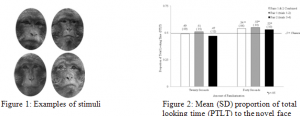Ross Magnum and Dr. Ross Flom, Department of Psychology
Experience plays a critical role in the development of infants’ perceptual abilities. Studies have shown that during the early stages of development, about six months of age, infants are capable of discriminating between a large number of faces, including faces from different species or races (Pascalis, 2002). Some time after 6 months of age, infants begin to develop a facial “prototype” according to the various faces towards which they have the most familiarity. While they gain expertise on this particular face type, they lose their generalized ability to discriminate between broad ranges of different faces, a phenomenon known as “perceptual narrowing” (Pascalis, 2002). In support of this claim, Pascalis (2005) found that 6-month-olds, but not 9-month-olds, can discriminate Barbary Macaque faces when given 20 seconds of familiarization and two 5-second comparison (test) trials
The phenomenon of perceptual narrowing is not permanent. It has been proven experimentally that if a 6-month old infant is shown pictures of a particular set of faces (for example pictures of various monkey faces) during a three-month period after being tested, the then 9-month old infant is able to discriminate between different faces in a comparable manner to that of 6-month old infants (Pascalis 2005). Thus, the ability of infants to discriminate faces can be extended with additional experience to a specific set of stimulus.
To further expand understanding of the concept of perceptual narrowing, we will conduct similar experiments with 12-month-olds to demonstrate that, with experience, the ability to discriminate can be reinstated in infants older than 6 months. The data in this report represents just the initial phase of our study. In this phase, we are investigating whether or not increased familiarization and looking time will improve the ability of 12-month-old infants to discriminate between different faces using images of Barbary macaques. The next phase of our study will specifically analyze the possibility of extending the discriminatory ability to 12-month-old infants under the conditions originally presented by Pascalis (2005).
Method
Forty-eight 12-month-olds were familiarized to a static color display of a Barbary Macaque (Macaca sylvanus).The faces used by Pascalis et. al. (2002) were used in the current experiment (Figure 1). Infants were randomly assigned to one of two familiarization conditions (40s or 20s). During familiarization, infants saw the same face side-by-side on two video monitors. Following familiarization infants received two test trials where the face of familiarization was presented on one video monitor and a novel face was presented on the adjacent monitor. For those infants who received 40s of familiarization, each visual-paired comparison test trials was 10s in length, and for those infants who received 20s of familiarization, each test trials was 5s in length. The lateral position of the novel face was alternated between the two test trials. Following the two test trials the procedure was repeated where each infant received a different face for familiarization and paired comparison.
Results and Discussion
The primary dependent variable was infants’ proportion of total looking time (PTLT) directed toward the novel face. The infants’ PTLT to the novel face are presented in Figure 2. Following 20s of familiarization and the two 5s visual-paired comparison test trials 12-month-olds failed to show a reliable preference for either the novel or familiar face M = 49%; t (23) = .98, p > .1 Within the 20s familiarization condition 12-month-olds’ looking behavior between the first familiarization and test-trial pairing and the second pairing did not significantly differ (p>.1). However, following 40s of familiarization and two 10s test trials, 12-month-olds showed reliable discrimination of the novel and familiar monkey face M = 54%; t (23) = 3.1, p = .015. In addition, 12-month-olds showed reliable discrimination for the first pair M = 55%; t (23) = 2.8, p = .02, as well as the second, M = 53%; t (23) = 2.6, p = .02. Finally, infants looking to the novel face was significantly longer in the 40s familiarization condition compared to the 20s condition t (23) = 4.1, p < .01. Thus 12-month-olds showed reliable discrimination when provided longer familiarization and increased time to visually compare the two faces.
These results demonstrate that infants’ ability to discriminate unfamiliar monkey faces is not “lost” or is “perceptually narrowed” during the course of development. Specifically, our results demonstrate that 12-month-olds, who have limited exposure and time to compare the two faces, do not show significant evidence of discriminating the novel and familiar face whereas those infants who received longer periods of familiarization and comparison reliably discriminated the faces.
References
- Fagan, J. F. (1972). Infants’ recognition memory for faces. Journal of Experimental
Child Psychology, 14, 453-476. - Pascalis, O., de Hann, M., & Nelson, C.A., (2002). Is face processing species-specific during the first year of life? Science, 296, 1321-1323
- Pascalis, O., & de Schonen, S. (1994). Recognition in 3- to 4-day-old human neonates. NeuroReport, 5, 1721-1724.
- Pascalis, O., Scott, L.S., Kelly, D. J., Shannon, R.W., Nicholson, E., Coleman, M., & Nelson, C.A. (2005). Plasticity of face processing in infancy. Proceedings of the National Academy of Sciences, USA, 102, 5297-5300.
- Scott, L.S., Pascalis, O., & Nelson, C.A. (2007) A domain general theory of the development of perceptual discrimination. Current Directions in Psychological Science, 16(4), 197-201

